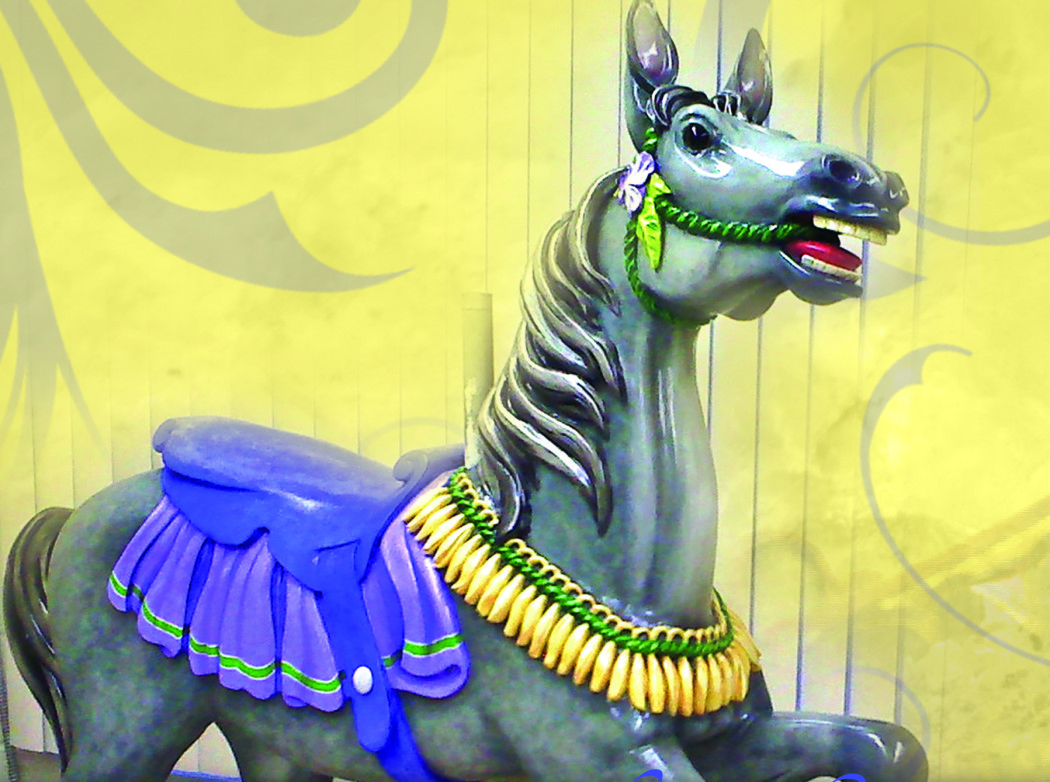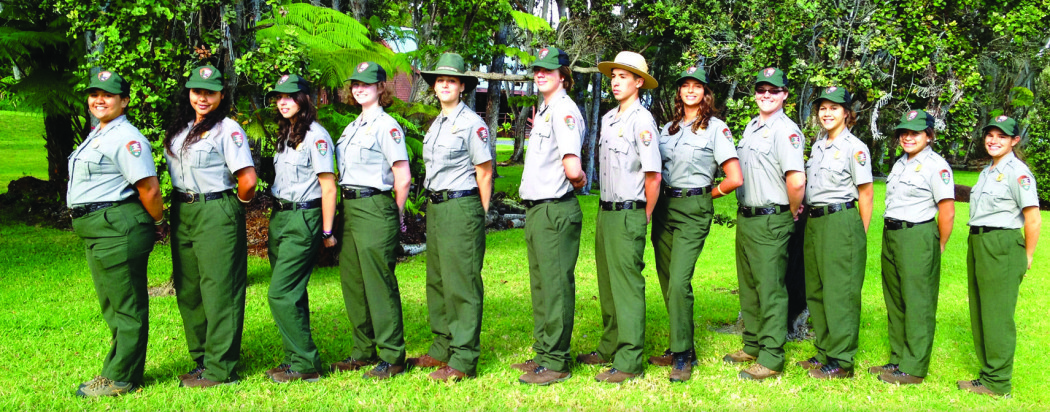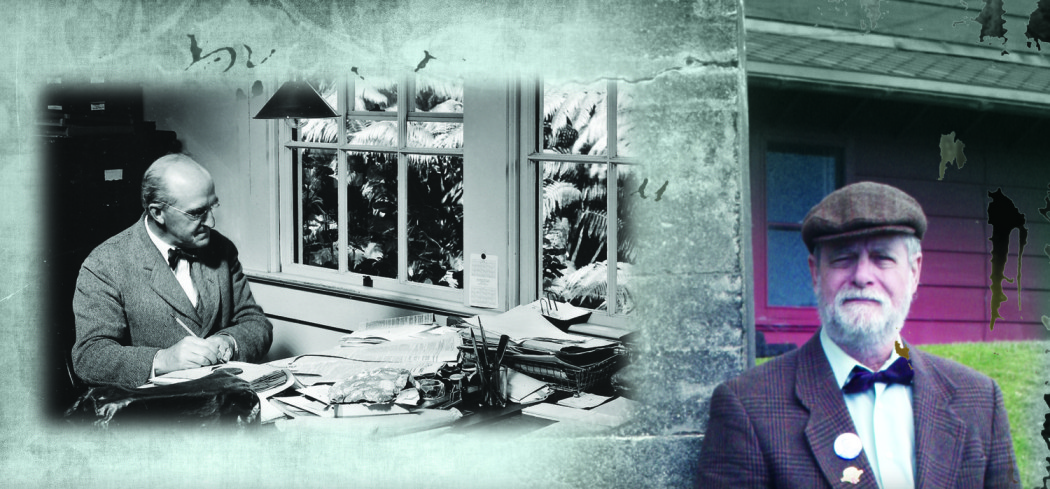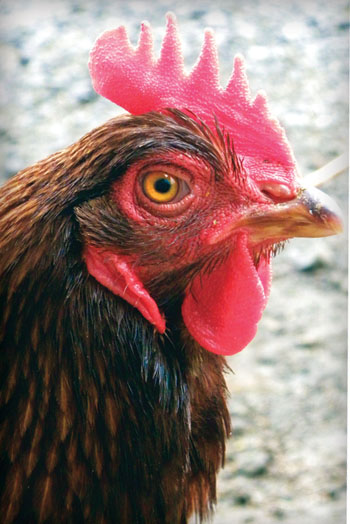
Carousel of Aloha: Bringing a Dream to Life
 By Alan D. McNarie
By Alan D. McNarie
Juanette Baysa has a dream. It’s not a dream that will lead to an end to all war or a universal source of clean energy or anything that ambitious. It’s just the sort that helps to make life a little nicer. It involves a little park on a plot of land somewhere along Volcano Highway. In the center of that park in her dream is an old-fashioned carousel—a uniquely Hawaiian one. It has hand-carved pā‘ū horses and monk seals and dophins and green sea turtles and even an octopus: animals that represent each of the major islands of Hawai‘i, each painted in the colors of that island and decorated with the official lei of the flowers of that island.
Many of us have pleasant dreams; more often than not they remain just dreams. But Juanette is working hard to make her dream a reality, and others are buying into the dream too.
The goals of the “Carousel of Aloha” are multiple, according to Juanette’s sister Jeanette: to build tourism, to educate visitors about Hawai‘i and to provide a chance for kids to build pleasant memories in a stretch of Puna that has few recreational opportunities for youth.
“You can go someplace and not need to spend money and still feel safe and enjoy yourself and have a great time,” she says.
Juanette, Jeanette and Katherine Patton, who also co-founded the Hilo Coffee Mill together, have formed a non-profit organization called Paradise Ponies to see the carousel park come to fruition. Juanette has been studying under master carousel carver Ken Means in Oregon for the past 15 years. Last February, they brought Means to Hawai‘i to teach a class on how to create the blanks, the laminated wood blocks from which the animals are carved. Means will be returning early next year to teach a course on the actual carving. Paradise Ponies has located a company to build the mechanical portion of the carousel and has put out a statewide call for artists to carve the blanks. And it’s setting up the organizational structure to make the carousel happen: a board of directors and an advisory board that includes Means; a Hawai‘i Island based design panel and project managers to coordinate carvers in each county. The organization is also seeking volunteers for everything from sanding to fundraising.
“Each island will have at least three figures that represent their island,” arranged together in a pie-piece-shaped section of the carousel, says Juanette. Current plans call for two more pie pieces to be reserved for figures modeled on Hawai‘i’s endangered species, such as a humpback whale calf or a nēnē; two more sections will have wheelchair-accessible “chariots,” including one shaped like a throne in honor of Hawai‘i’s monarchy.
The central design committee will be responsible for the technical details of fitting all those efforts together. For instance, since the carousel figures will be arranged in three concentric circles, the innermost figures may need to be shorter than the outermost ones. Baysa hopes to have an octopus designed for the innermost row. A whale would probably be consigned to the outermost ring.
One thing that the carousel won’t have is a calliope. “Band organs don’t do well in this humidity,” Juanette observes sadly. “We would have rust up the yingyang.” Instead, plans call for a sound system playing calliope-like synthesizer arrangements of traditional Hawaiian melodies.
Carousel animals, Juanette says, “have always brought joy to my face. One of my fondest memories as child was riding on a carousel, looking at all the gorgeous artwork, and being able to touch it. You could hang on to the pole and reach around and touch the mane of the horse. It was a real tactile experience. So many times when you go to museums, you’re held back behind a rope and you can’t touch the artwork or interact with it.”
Fifteen years ago, in a magazine called Carousel News and Trader, Juanette discovered an ad for summer carousel animal carving workshops with Means. At the time, she had a fine arts degree from California State University at Fresno, but no experience as a woodcarver.
“I called Ken and said I wanted to enroll in his class and he literally tried to talk me. out of it,” she recalls. “He asked what carving experience I had and I said, ‘None,’ and he asked me what tools I had, and I said, ‘None,’ and he said, ‘Maybe you should try something a little smaller.’”
But Juanette persisted, and Means finally relented, even allowing her to use his tools on the condition that she buy her own by the time she left Oregon.
“I’ve been going back there every summer since, with the exception of two years,” she says. “I finally moved to Oregon and studied with him year-round for almost four years before coming back home.”
When she was in her 30s, she says, she attended a spiritual retreat. “The facilitator asked everybody in the group what we were going to do to make this world a better place when we left this plane of existence,” she recalls. “I said I wanted to carve one carousel animal for each island, carved to represent that island and painted in that island’s colors and donate it to the pediatrics ward of a hospital there. The facilitator looked at me and smiled and said, ‘That’s not big enough,’ and she walked out of the room.”
She pondered the facilitator’s words for a year and a half. Then, one day, she was taking her goddaughter on a play date in Honolulu. “We would go to this little play area across from Pearl Ridge. It had one of these little fiberglass carousels that she loved to ride on. Just a little teeny-tiny thing,” Juanette says.
But when they got there this day, they found the play area had closed, and the little carousel was no longer there.
“It’s okay, Aunty, we’ll just have to make one,” her goddaughter said.
“Then a voice spoke in my head, and said, ‘That is enough.’” Juanette remembers. And thus the Carousel of Aloha was born.
At the Sunday Farmer’s Market that Hilo Coffee Mill hosts near Kurtistown, Juanette sits in the open door of the coffee warehouse with the first carousel horse she carved, and talks with visitors about the project. There are different styles of carousel horses, she explains; this one is “a Parker horse.”
“It’s a very simple and stylized animal, and perfect for a beginner,” she says. “I had to make it Hawaiian, so I put the lei on her, and she’s a girl, so I put a skirt on her to kind of emulate the skirts of the pā‘ū riders.”
She’s currently at work on two other, more ambitious figures. One, currently in Oregon, is an elaborate “sea horse”—more correctly, a hippocampus, a mythical creature whose front half is a horse’s head, chest and forelegs, while the back end is a long, curling fish’s tail. The other animal, sitting in pieces in the warehouse behind her, is a very realistic “Kona nightingale,” a donkey such as the ones which once trundled bags of coffee up and down the slopes of Mauna Loa. Juanette is carving that one for the coffee mill.
The process starts out with research: Juanette carefully examined real donkeys, for example, getting down their proportions, their musculature, the way they moved. Then she creates a full-scale “cartoon” or sketch of the animal, from which she builds up the blank, a block made of pieces of basswood laminated together to the actual size. The size and shape of the blank varies according to the animal: a horse blank may look considerably different than one that’s destined to become an octopus. There actually may be several blanks for one figure: unlike, say, a tiki, a carousel animal is carved in pieces—the trunk, the limbs, the head—which are then put together with pegs and glue. Basswood is used, Juanette says, because it “is a soft hardwood, it is very dense and it has a very, very fine grain, which allows you to do all kinds of fine detail. It was the chosen wood of carousel figure makers back when carousels were in their heyday.”
That heyday was considered by many to come in early 20th-century America, when carousels blossomed in carnivals, amusement parks and city parks across the country. They were taken to new heights of imagination, sophistication and craftsmanship by artisans such as the Dentzell family of Philadelphia, known for their clockwork-reliable mechanisms and their fanciful wooden menageries; Charles I. D. Looff, who designed the first Coney Island carousel; and Charles W. Parker of Kansas, the creator of the “Parker horse.” But the history of the device goes back much, much further; the earliest depiction of a carousel was in a Byzantine bas relief dating back to around 500 A.D., making it probably the oldest amusement ride that didn’t involve actually riding on a living animal. But the earliest carousels may not have been strictly for amusement; they may have been training devices for apprentice cavalry lancers.
Juanette is working directly out of that illustrious tradition. She sometimes uses a Dremel power tool for fine details such as the mane, but mostly she works with traditional hand tools; she much prefers the gentle tap, tap, tap of a mallet and chisel to the high-pitched whine of an electric tool. Carving takes skill and care; it’s the art of subtracting everything that doesn’t look like a horse, and a single slip of a chisel can lead to, at best, a painstaking repair job, and at worst, a ruined figure. While working on her first horse, she remembers, she accidentally chipped off a piece of its tongue.
“It flew off into somebody else’s chip pile,” she recounts. “I spent 45-minutes on my hands and knees, saying, “Nope, that’s not it, that’s not it. Picking another one up….”
When Hawai‘i’s carousel comes to fruition, it will be the work of many hands with many skills and many levels of skills. Aspiring woodcarvers are welcome to come to the Paradise Ponies classes and learn. And as vital as the carving, in terms of creating a figure that will look beautiful and last for generations, is blank-building, sanding and painting.
“In Oregon there were some ladies who lived in a retirement home. Many of them had arthritis, so they weren’t able to hold a chisel and a mallet to carve,” notes Juanette. “But they wanted to be a part of the carousel. Every Saturday, they would bring their little thermos mugs and their little box of donuts, and they would sit and talk and sand. When somebody [a carver] finished a leg on a horse or whatever, they would sand it and get it ready for gluing. If there were details, they would sand the details. That was their contribution to the carousel—every bit as important as the carving.”
Equally important are other jobs that have nothing to do with wood. Jeanette notes that the nonprofit needs help to write grants, make donation boxes, man fundraising booths and work on the website. “The most urgent need we have is money,” she says, but every hour volunteered can help with that, too, by serving as “in kind” donations when the nonprofit needs matching funds for grants. And there are needs that involve not time, but space. They’re still looking for 20 acres or so in which to locate the park. And they’d like to find somewhere public to hold classes and display the figures.
“We want people of all ages to be involved in this,” says Juanette. Especially, she adds, “We want to involve the young people. Young people will have the most enthusiasm, we think. It will be their children who get to ride the carousel. It will be them and their children and their children’s children.” ❖
Contact writer Alan D. McNarie: amcnarie@yahoo.com
Photos courtesy of Paradise Ponies, Inc.
For more information:
Paradise Ponies, Inc., P.O. Box 1030, Kurtistown, HI 96760
Phone: 808.315.1093
Website: CarouselOfAloha.org


